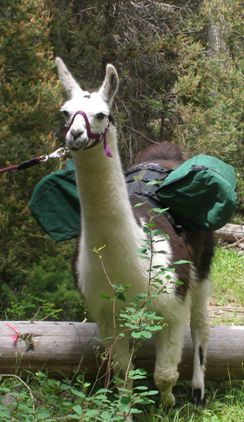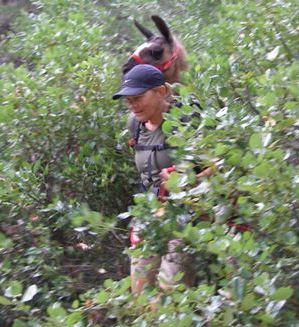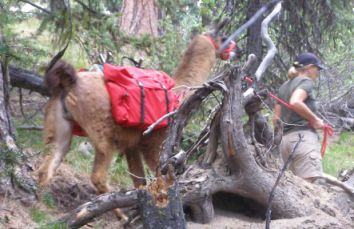Changes to Pack Trial Level Requirements as of February 2016
Pack Trial standards were originally designed from the perspective of people packing in the Rocky Mountains and similar terrain. Over the years it has become clear that llamas pack in all sorts of environments and in all kinds of terrain. Pack Trials measure three aspects of a llama's ability, attitude, skill and fitness. A llama successfully earning a PLTA certificate has shown that it has acquired appropriate skill in dealing with packing demands, and has an attitude suitable to the venture and has shown that it is properly physically conditioned to handle the demands of packing. Skill is measured by the number and types of obstacles the llama must deal with. Attitude is clearly demonstrated by the llama’s willingness to complete the obstacles and the course. Fitness is measured by the llama’s ability to complete a specific distance and elevation gain carrying a load.
To make PLTA pack trails adaptable to varying conditions while still maintaining stringent standards the Board of Directors has approved changes in the way distances and elevations are calculated and in the selection of obstacles. The procedures and regulations stated in the 2010 Pack Trial Handbook remain the basis for administering a pack trial, but the standards for the different levels are explained as follows.
I. Distance and Elevation Gain
A pack llama’s fitness must be adequate for the environment in which they pack. To say that all pack llamas must be able to handle the type of conditions presented by rugged mountainous terrain in order to be considered pack llamas is inappropriate, yet requiring PLTA certified llamas to demonstrate a high level of fitness is appropriate. To address this situation, the PLTA Board of Directors has adjusted the distance and elevation requirements so that mileage can be increased to replace elevation gain at a factor of 250 feet per mile, and allowed that this increase may be accumulated in quarter mile increments.
Distance/elevation standards have changed as follows:
|
Trial |
Previous Minimum Requirements |
Revised Minimum Requirements (miles/elevation gain) |
|
|
Miles |
Elevation Gain |
||
|
Basic |
3 |
250 |
3/250, 4/0 |
|
Advanced |
5 |
750 |
5/750, 6/500, 7/250. 8/0 |
|
Master |
8 |
1500 |
8/1500, 9/1200, 10/750, 11/500, 12/250, 13/0 |
|
Elite |
10 |
3000 |
10/3000, 11/2750, 12/2500, 13/2250, 14/2000, |
The Board of Directors instituted the revised requirements on December 16th, 2014. The ratios shown are for full miles, however, adjustments can be implemented in quarter mile increments, thus the ratios are 250 feet per mile, 188 feet per three-quarters mile, 125 feet per half mile, and 63 feet per quarter mile. In practical application this means that if a Basic trial course is found to have only 100 feet of elevation gain, the missing 150 feet can be compensated for by adding three-quarters of a mile. The total course length then becomes three and three-quarters miles.
In essence nothing has changed in terms of required exertion or fitness. This adjustment simply makes it possible for llamas living in flat or rolling landscapes to demonstrate their competence as clearly as those who pack in rugged mountains. The Board found this to be a fair and reasonable solution to a problem that has excluded many llamas and their owners from participating in PLTA Pack Trials.
II. Obstacles
On February 16th, 2016, the PLTA Board of Directors approved changes to the way obstacles are chosen. Rather than require specific obstacles, regulations now allow obstacles to be chosen based on the type of challenge they represent to the llama. Listed below are the seven categories, their definitions, and recommended obstacles that fit the definition. Depending on the location of the trial, there may well be other obstacles that fit a category's definition. Unless specified otherwise, the Trial Marshal, with the Certifier's approval, is permitted to use those obstacles while keeping in mind that safety is paramount. Definitions of specific obstacles as listed in the 2010 Pack Trial Handbook continue to apply. See the website article Pack Trial Obstacle Descriptions and Definitions.
 Picking One's Way: The llama is required to move carefully through material that obscures and complicates footing
Picking One's Way: The llama is required to move carefully through material that obscures and complicates footing
- Deadfall, Slash
- Rock rubble
- Dense deep grass
Foot Fears: The llama must walk through a medium into which the feet sink.
- Water
- Mud
- Deep, loose sand, cinder, or gravel
- Soft snow eight to twelve inches deep
Up/Over/Across: The llama must negotiate an obstacle that requires extending its stride to climb or stretch.
- High step up
- High step down
- Jump / step over high obstacle such as a log
- Jump / step over a low obstacle such as a ditch
Tight Places: The llama is required to negotiate a space that allows limited room to maneuver and that impinges on the llama's personal space.
- Brush
- Duck under
- Weave
- Tunnel
- Back & turn
- Squeeze
Slippery Slope: The llama is required to negotiate a slope of greater than 45 degrees that has loose footing and which may cause load shift.
- Steep slope up
- Steep slope down
- Steep side-hill with narrow (8 inch) tread
Load Management: The llama must tolerate adjustments or handling of tack or llama's body, exclusive of head and halter.
- Top-loading (secure an item to, or remove and item from the top of the saddle)
- Accessing panniers (insert an item into, or remove an item from a pannier)
- Putting on a rain cover
- Adjusting cinches
Trail Hazards: The llama must tolerate unexpected trail conditions including structures, debris, livestock, people, pets, or machines
- Dogs, horses, cows, backpacker
- Bicycle, motorbike, ATV
- Bridge, gate, puncheon
- Garbage or plastic sheet piled up or flapping
III. Level Requirements
The requirements for each level of certification have been adjusted to provide a more consistent progression of difficulty and to accommodate the changes in the way obstacles are selected. Simple obstacles require attention to a single easy item or issue while complex obstacles include dealing with multiple more challenging concerns.
BASIC: Five simple obstacles demonstrating the llama's willingness to follow the handler.
- Up/over/Across: any obstacle from category
- Foot Fear: any obstacle from category
- Picking One's Way: any obstacle from category
- Tight Places: any obstacle from group
- Trial Marshal's choice

ADVANCED: Ten obstacles demonstrating the llama's ability to negotiate typical trail conditions.
- Up/over/Across: any obstacle from category
- Foot Fear: water (if possible)
- Picking One's Way: deadfall
- Picking One's Way: rubble
- Tight Places: any obstacle from category
- Slippery Slope: any obstacle from category
- Load Management: any obstacle from category
- Category a*: Trial Marshal's choice
- Category b*: Trial Marshal's choice
- Category c*: Trial Marshal's choice
*8 - 10 are chosen from three different categories
MASTER: Fifteen complex obstacles requiring skill, agility and responsiveness. All categories must be represented.

- Up/over/Across: any obstacle from category
- Foot Fear: water (if possible)
- Picking One's Way: deadfall
- Picking One's Way: rubble
- Tight Places: brush
- Slippery Slope: any obstacle from category
- Load Management: panniers off and foot inspection
- Combinations of obstacles from two or more categories: Trial Marshal's choice
- Combinations of obstacles from two or more categories: Trial Marshal's choice
- Combinations of obstacles from two or more categories: Trial Marshal's choice
- Combinations of obstacles from two or more categories: Trial Marshal's choice
- Combinations of obstacles from two or more categories: Trial Marshal's choice
- Combinations of obstacles from two or more categories: Trial Marshal's choice
- Combinations of obstacles from two or more categories: Trial Marshal's choice
- Combinations of obstacles from two or more categories: Trial Marshal's choice
ELITE: Twenty obstacles combining two or more categories. All categories must be represented.
MASTER and ELITE STRING: Llama must change position in the lineup for a minimum of one quarter mile.
IV. Additional Recognition
Once a llama has earned a certificate at a given level, it continues to be eligible to participate. The additional successful trials are added to the llama's title as stars, somewhat similar to what we do with our military generals. For example, a Master Pack Llama may continue to enter trails. For each successful one following certification she will earn a star, making it possible to be a Two Star, Three Star, or even Five Star or more Master Pack Llama.
Program Links
-
PLTA Challenge Program Rules and Procedures
-
PLTA Mileage Program
-
Packer's Primer Details
-
Challenge Forms
-
PLTA Programs
-
Packer's Challenge
-
Pack Trials
-
Pack Trial Forms
-
Pack Trial In A Box: What You Need With You for Running The Trial
-
PLTA Pack Trial Manual: How to Stage a Pack Trial Event
-
How to Become a Pack Trial Certifier
-
Pack Trial Governance Committee
-
Late Fees
